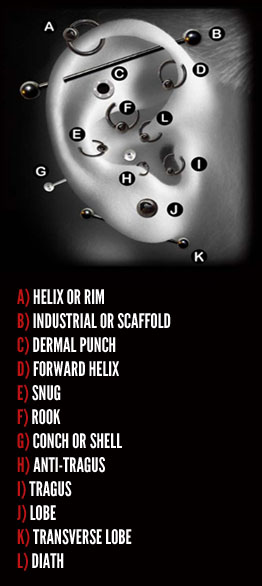Frequently Asked Questions
Common Ear Piercings

Helix Piercing
This is a type of piercing where the cartilage or the upper ear is punctured so that an earring can be placed. More often than not, a piercing gun is used to pierce the ear. But there are others who just use a bigger needle in order to create a helix piercing. Ear jewelries that are used for this are the studs or bead rings.
Scaffold piercing
This is also known as the industrial piercing. In this type of ear puncture, there are two pierces located in the ear cartilage or helix. These are just like two helix piercings but connected together with a barbell earring.
Rook piercing
This is a puncture done at the ear’s antihelix. It is actually considered as one of the most painful ear piercings since the needle would pass in different cartilage tissues of the ear. Moreover, it is also known to be very difficult to perform at the same time.
Daith piercing
This is a type of perforation done at the ear’s cartilage so that a jewelry can be inserted. Using a curved needle, the daith piercing is performed. This is to prevent the other ear parts from being damaged due t piercing. Some also use a receiving tube as well that would catch the needle on the other side. More often than not, people use ear jewelries with small gauges so it can be easily inserted just like the captive bead ring.
Snug piercing
This is located at the inner cartilage of the ear. It is at the lower part of the ear’s outer rim. More often than not, a snug piercing is shallow compared to the other types or ear piercing locations. Aside from that, a micro-jewelry can only be used as well. Earrings known as the curved barbells are usually used for snug piercing.
Conch piercing
There are actually two types of conch earring namely the inner conch piercing and the outer conch piercing. The inner conch piercing is done at the center of the ear’s cartilage. This is just adjacent to the part called ear canal. When doing the inner conch piercing it is important that you use a big gauge piercing needle and put a barbell ear accessory as well. On the other hand, the outer conch piercing can be found at the outer cartilage of the ear. It can be found at the flat area of the outer ear. As long as the perforation is at the flat part of the cartilage, it is still considered as an outer conch pierce. However, if it is already done at the curled portion of the ear, it is already called as the helix piercing.
Lobe piercing
This is probably the most common part of the ear that is being punctured. The lobe is considered as the softest and the biggest part of the ear. The ear’s lobe can actually accommodate as much as three piercings because of its size.
Piercing Polices
We require that all piercees be alcohol free, and request that they have eaten a meal within 4 hours prior to a piercing. We pierce those 18 or older with valid photo ID, 16 or older with parental consent and corresponding IDs.
Acceptable IDs include:
- Driver's License
- Passport
- Military ID
- State non-driver's ID
- Birth Certificate, with photo ID
In order to pierce a minor (under 18), we will need their ID, showing photo, name and birthdate (see above list), as well as that of the adult signing for them. Only parents or legal guardians can sign for a minor. In the event of different last names, addresses, etc., we will need paperwork proving legal custody. This can include court papers, change of name forms, birth certificates, insurance cards with both names, or school transcripts or medical bills including the minor's name but addressed to the guardian.
We need the ID every time you need any procedure performed, even if you have shown it on a prior occasion.
Body Piercings & Healing Times
| Pierced body part | Healing time |
| Ear lobe | 4 to 6 weeks |
| Ear cartilage | 4 months to 1 year |
| Eyebrow | 4 to 6 weeks |
| Nostril | 2 to 4 months |
| Nasal septrum | 6 to 8 months |
| Nasal bridge | 8 to 10 weeks |
| Tongue | 4 weeks |
| Lip | 2 to 3 months |
| Nipple | 3 to 6 months |
| Navel (belly button) | 4 months to 1 year |





